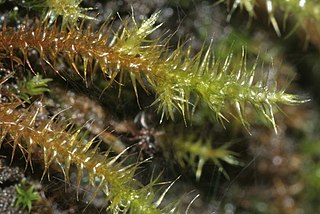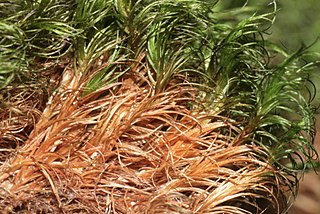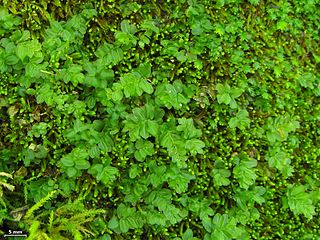
Funaria is a genus of approximately 210 species of moss. Funaria hygrometrica is the most common species. Funaria hygrometrica is called “cord moss” because of the twisted seta which is very hygroscopic and untwists when moist. The name is derived from the Latin word “funis”, meaning "a rope". In funaria root like structures called rhizoids are present.
Neckeropsis is a genus of plant in the family Neckeraceae.
Molendoa is a genus of moss in family Pottiaceae.
Pinnatella is a genus of moss in family Neckeraceae.

Thamnobryum is a genus of moss in the family Neckeraceae. There are about 50 species. The genus is distributed throughout the world.

Grimmia is a genus of mosses (Bryophyta), originally named by Jakob Friedrich Ehrhart in honour of Johann Friedrich Carl Grimm, a physician and botanist from Gotha, Germany.

Pogonatum is a genus of mosses — commonly called spike moss — which contains approximately 70 species that cover a cosmopolitan distribution. It can be seen mostly in Asian countries with a tropical climate.

Ditrichum is a genus of haplolepideous mosses (Dicranidae) in the family Ditrichaceae.

Racomitrium is a genus of mosses in the family Grimmiaceae established in 1818 by Samuel Elisée Bridel-Brideri. It contains the following species:

Schistidium is a plant genus in the moss family Grimmiaceae.

Amblystegiaceae is a family of mosses. It includes 20 to 30 genera with a total of up to 150 species. They occur nearly worldwide, growing in tropical, temperate, and subpolar regions.

Campylopus is a genus of 180 species of haplolepideous mosses (Dicranidae) in the family Leucobryaceae. The name comes from the Greek campylos, meaning curved, and pous, meaning foot, referring to the setae which curve downwards.

Thuidium is a genus of moss in the family Thuidiaceae. The name comes from the genus Thuja and the Latin suffix -idium, meaning diminutive. This is due to its resemblance to small cedar trees.

Didymodon is a genus of mosses belonging to the family Pottiaceae. The genus has a cosmopolitan distribution..

Neckera is a large genus of mosses belonging to the family Neckeraceae. The genus was first described by Johann Hedwig. The genus has a cosmopolitan distribution.

Rhynchostegium is a genus of pleurocarpous mosses belonging to the family Brachytheciaceae. The genus has a cosmopolitan distribution across different climatological regions except the polar regions, mostly in tropic to north temperate regions. The genus contains both aquatic and terrestrial species. The genus was named for their rostrate opercula. The type species of this genus is Rhynchostegium confertum (Dicks.) Schimp.

Rhodobryum is a genus of mosses belonging to the family Bryaceae.
Pylaisia is a genus of mosses belonging to the family Pylaisiaceae.
Leskeaceae is a family of mosses belonging to the order Hypnales.














